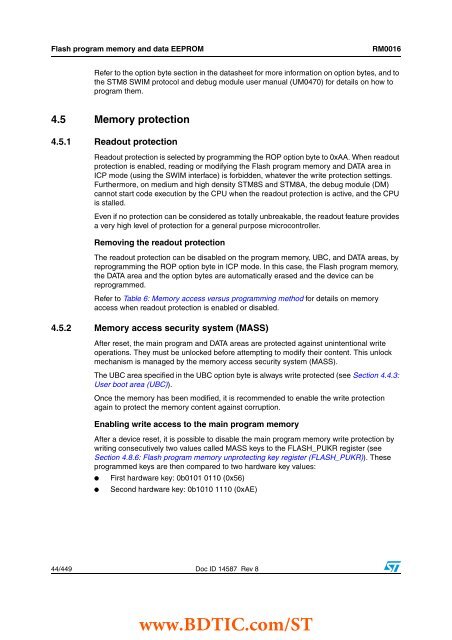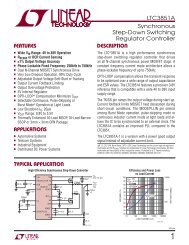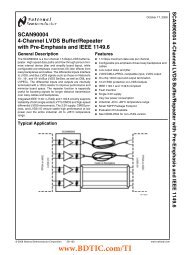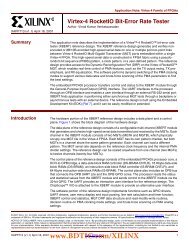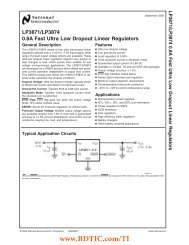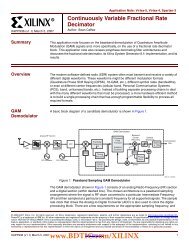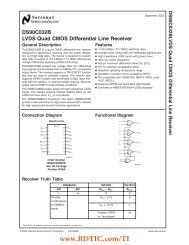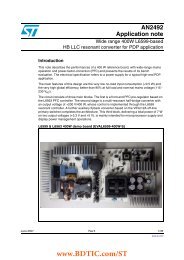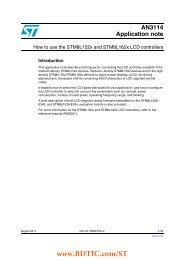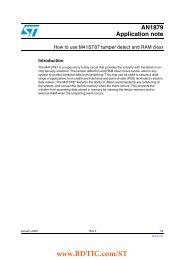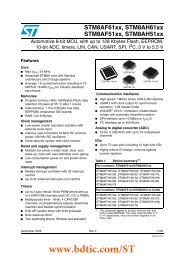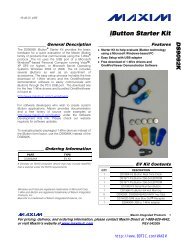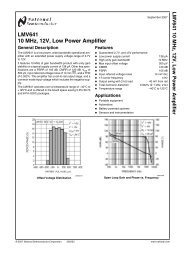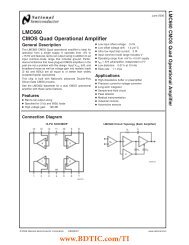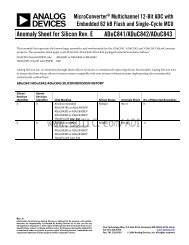- Page 1 and 2: RM0016 Reference manual STM8S and S
- Page 3 and 4: RM0016 Contents 4.5.3 Enabling writ
- Page 5 and 6: RM0016 Contents 9.7 Clock-out capab
- Page 7 and 8: RM0016 Contents 13.3.1 Beeper contr
- Page 9 and 10: RM0016 Contents 17.7.12 Capture/com
- Page 11 and 12: RM0016 Contents 19.6.9 Auto-reload
- Page 13 and 14: RM0016 Contents 22.4 LIN mode funct
- Page 15 and 16: RM0016 Contents 24.2 ADC main featu
- Page 17 and 18: RM0016 List of tables List of table
- Page 19 and 20: RM0016 List of figures List of figu
- Page 21 and 22: RM0016 List of figures (BDM = 0 and
- Page 23 and 24: RM0016 Central processing unit (CPU
- Page 25 and 26: RM0016 Central processing unit (CPU
- Page 27 and 28: RM0016 Central processing unit (CPU
- Page 29 and 30: RM0016 Boot ROM 2 Boot ROM The inte
- Page 31 and 32: RM0016 Memory and register map 3.1.
- Page 33 and 34: RM0016 Memory and register map 3.2
- Page 35 and 36: RM0016 Flash program memory and dat
- Page 37 and 38: RM0016 Flash program memory and dat
- Page 39 and 40: RM0016 Flash program memory and dat
- Page 41 and 42: RM0016 Flash program memory and dat
- Page 43: RM0016 Flash program memory and dat
- Page 47 and 48: RM0016 Flash program memory and dat
- Page 49 and 50: RM0016 Flash program memory and dat
- Page 51 and 52: RM0016 Flash program memory and dat
- Page 53 and 54: RM0016 Flash program memory and dat
- Page 55 and 56: RM0016 Flash program memory and dat
- Page 57 and 58: RM0016 Single wire interface module
- Page 59 and 60: RM0016 Interrupt controller (ITC) T
- Page 61 and 62: RM0016 Interrupt controller (ITC) C
- Page 63 and 64: RM0016 Interrupt controller (ITC) m
- Page 65 and 66: RM0016 Interrupt controller (ITC) F
- Page 67 and 68: RM0016 Interrupt controller (ITC) 6
- Page 69 and 70: RM0016 Interrupt controller (ITC) 6
- Page 71 and 72: RM0016 Interrupt controller (ITC) 6
- Page 73 and 74: RM0016 Reset (RST) 8 Reset (RST) Th
- Page 75 and 76: RM0016 Reset (RST) 8.3.2 Watchdog r
- Page 77 and 78: RM0016 Clock control (CLK) 9 Clock
- Page 79 and 80: RM0016 Clock control (CLK) 9.1 Mast
- Page 81 and 82: RM0016 Clock control (CLK) 9.1.3 LS
- Page 83 and 84: RM0016 Clock control (CLK) The SWBS
- Page 85 and 86: RM0016 Clock control (CLK) Figure 2
- Page 87 and 88: RM0016 Clock control (CLK) 9.6 Cloc
- Page 89 and 90: RM0016 Clock control (CLK) 9.9 CLK
- Page 91 and 92: RM0016 Clock control (CLK) 9.9.3 Cl
- Page 93 and 94: RM0016 Clock control (CLK) 9.9.6 Cl
- Page 95 and 96:
RM0016 Clock control (CLK) 9.9.8 Pe
- Page 97 and 98:
RM0016 Clock control (CLK) 9.9.10 C
- Page 99 and 100:
RM0016 Clock control (CLK) 9.9.12 S
- Page 101 and 102:
RM0016 Power management 10 Power ma
- Page 103 and 104:
RM0016 Power management 10.2.1 Wait
- Page 105 and 106:
RM0016 General purpose I/O ports (G
- Page 107 and 108:
RM0016 General purpose I/O ports (G
- Page 109 and 110:
RM0016 General purpose I/O ports (G
- Page 111 and 112:
RM0016 General purpose I/O ports (G
- Page 113 and 114:
RM0016 General purpose I/O ports (G
- Page 115 and 116:
RM0016 Auto-wakeup (AWU) 12.3 AWU f
- Page 117 and 118:
RM0016 Auto-wakeup (AWU) Example 1
- Page 119 and 120:
RM0016 Auto-wakeup (AWU) 12.4.3 Tim
- Page 121 and 122:
RM0016 Beeper (BEEP) 13.2.2 Beeper
- Page 123 and 124:
RM0016 Independent watchdog (IWDG)
- Page 125 and 126:
RM0016 Independent watchdog (IWDG)
- Page 127 and 128:
RM0016 Window watchdog (WWDG) Figur
- Page 129 and 130:
RM0016 Window watchdog (WWDG) Figur
- Page 131 and 132:
RM0016 Window watchdog (WWDG) Bits
- Page 133 and 134:
RM0016 Timer overview 16.1 Timer fe
- Page 135 and 136:
RM0016 Timer overview Table 36. Exp
- Page 137 and 138:
RM0016 16-bit advanced control time
- Page 139 and 140:
RM0016 16-bit advanced control time
- Page 141 and 142:
RM0016 16-bit advanced control time
- Page 143 and 144:
RM0016 16-bit advanced control time
- Page 145 and 146:
RM0016 16-bit advanced control time
- Page 147 and 148:
RM0016 16-bit advanced control time
- Page 149 and 150:
RM0016 16-bit advanced control time
- Page 151 and 152:
RM0016 16-bit advanced control time
- Page 153 and 154:
RM0016 16-bit advanced control time
- Page 155 and 156:
RM0016 16-bit advanced control time
- Page 157 and 158:
RM0016 16-bit advanced control time
- Page 159 and 160:
RM0016 16-bit advanced control time
- Page 161 and 162:
RM0016 16-bit advanced control time
- Page 163 and 164:
RM0016 16-bit advanced control time
- Page 165 and 166:
RM0016 16-bit advanced control time
- Page 167 and 168:
RM0016 16-bit advanced control time
- Page 169 and 170:
RM0016 16-bit advanced control time
- Page 171 and 172:
RM0016 16-bit advanced control time
- Page 173 and 174:
RM0016 16-bit advanced control time
- Page 175 and 176:
RM0016 16-bit advanced control time
- Page 177 and 178:
RM0016 16-bit advanced control time
- Page 179 and 180:
RM0016 16-bit advanced control time
- Page 181 and 182:
RM0016 16-bit advanced control time
- Page 183 and 184:
RM0016 16-bit advanced control time
- Page 185 and 186:
RM0016 16-bit advanced control time
- Page 187 and 188:
RM0016 16-bit advanced control time
- Page 189 and 190:
RM0016 16-bit advanced control time
- Page 191 and 192:
RM0016 16-bit advanced control time
- Page 193 and 194:
RM0016 16-bit advanced control time
- Page 195 and 196:
RM0016 16-bit advanced control time
- Page 197 and 198:
RM0016 16-bit advanced control time
- Page 199 and 200:
RM0016 16-bit advanced control time
- Page 201 and 202:
RM0016 16-bit advanced control time
- Page 203 and 204:
RM0016 16-bit advanced control time
- Page 205 and 206:
RM0016 16-bit advanced control time
- Page 207 and 208:
RM0016 16-bit advanced control time
- Page 209 and 210:
RM0016 16-bit advanced control time
- Page 211 and 212:
RM0016 16-bit advanced control time
- Page 213 and 214:
RM0016 16-bit advanced control time
- Page 215 and 216:
RM0016 16-bit advanced control time
- Page 217 and 218:
RM0016 16-bit general purpose timer
- Page 219 and 220:
RM0016 16-bit general purpose timer
- Page 221 and 222:
RM0016 16-bit general purpose timer
- Page 223 and 224:
RM0016 16-bit general purpose timer
- Page 225 and 226:
RM0016 16-bit general purpose timer
- Page 227 and 228:
RM0016 16-bit general purpose timer
- Page 229 and 230:
RM0016 16-bit general purpose timer
- Page 231 and 232:
RM0016 16-bit general purpose timer
- Page 233 and 234:
RM0016 16-bit general purpose timer
- Page 235 and 236:
RM0016 16-bit general purpose timer
- Page 237 and 238:
RM0016 16-bit general purpose timer
- Page 239 and 240:
RM0016 16-bit general purpose timer
- Page 241 and 242:
RM0016 16-bit general purpose timer
- Page 243 and 244:
RM0016 8-bit basic timer (TIM4, TIM
- Page 245 and 246:
RM0016 8-bit basic timer (TIM4, TIM
- Page 247 and 248:
RM0016 8-bit basic timer (TIM4, TIM
- Page 249 and 250:
RM0016 8-bit basic timer (TIM4, TIM
- Page 251 and 252:
RM0016 8-bit basic timer (TIM4, TIM
- Page 253 and 254:
RM0016 Serial peripheral interface
- Page 255 and 256:
RM0016 Serial peripheral interface
- Page 257 and 258:
RM0016 Serial peripheral interface
- Page 259 and 260:
RM0016 Serial peripheral interface
- Page 261 and 262:
RM0016 Serial peripheral interface
- Page 263 and 264:
RM0016 Serial peripheral interface
- Page 265 and 266:
RM0016 Serial peripheral interface
- Page 267 and 268:
RM0016 Serial peripheral interface
- Page 269 and 270:
RM0016 Serial peripheral interface
- Page 271 and 272:
RM0016 Serial peripheral interface
- Page 273 and 274:
RM0016 Serial peripheral interface
- Page 275 and 276:
RM0016 Serial peripheral interface
- Page 277 and 278:
RM0016 Serial peripheral interface
- Page 279 and 280:
RM0016 Inter-integrated circuit (I
- Page 281 and 282:
RM0016 Inter-integrated circuit (I
- Page 283 and 284:
RM0016 Inter-integrated circuit (I
- Page 285 and 286:
RM0016 Inter-integrated circuit (I
- Page 287 and 288:
RM0016 Inter-integrated circuit (I
- Page 289 and 290:
RM0016 Inter-integrated circuit (I
- Page 291 and 292:
RM0016 Inter-integrated circuit (I
- Page 293 and 294:
RM0016 Inter-integrated circuit (I
- Page 295 and 296:
RM0016 Inter-integrated circuit (I
- Page 297 and 298:
RM0016 Inter-integrated circuit (I
- Page 299 and 300:
RM0016 Inter-integrated circuit (I
- Page 301 and 302:
RM0016 Inter-integrated circuit (I
- Page 303 and 304:
RM0016 Inter-integrated circuit (I
- Page 305 and 306:
RM0016 Inter-integrated circuit (I
- Page 307 and 308:
RM0016 Universal asynchronous recei
- Page 309 and 310:
RM0016 Universal asynchronous recei
- Page 311 and 312:
RM0016 Universal asynchronous recei
- Page 313 and 314:
RM0016 Universal asynchronous recei
- Page 315 and 316:
RM0016 Universal asynchronous recei
- Page 317 and 318:
RM0016 Universal asynchronous recei
- Page 319 and 320:
RM0016 Universal asynchronous recei
- Page 321 and 322:
RM0016 Universal asynchronous recei
- Page 323 and 324:
RM0016 Universal asynchronous recei
- Page 325 and 326:
RM0016 Universal asynchronous recei
- Page 327 and 328:
RM0016 Universal asynchronous recei
- Page 329 and 330:
RM0016 Universal asynchronous recei
- Page 331 and 332:
RM0016 Universal asynchronous recei
- Page 333 and 334:
RM0016 Universal asynchronous recei
- Page 335 and 336:
RM0016 Universal asynchronous recei
- Page 337 and 338:
RM0016 Universal asynchronous recei
- Page 339 and 340:
RM0016 Universal asynchronous recei
- Page 341 and 342:
RM0016 Universal asynchronous recei
- Page 343 and 344:
RM0016 Universal asynchronous recei
- Page 345 and 346:
RM0016 Universal asynchronous recei
- Page 347 and 348:
RM0016 Universal asynchronous recei
- Page 349 and 350:
RM0016 Universal asynchronous recei
- Page 351 and 352:
RM0016 Universal asynchronous recei
- Page 353 and 354:
RM0016 Universal asynchronous recei
- Page 355 and 356:
RM0016 Universal asynchronous recei
- Page 357 and 358:
RM0016 Universal asynchronous recei
- Page 359 and 360:
RM0016 Universal asynchronous recei
- Page 361 and 362:
RM0016 Universal asynchronous recei
- Page 363 and 364:
RM0016 Controller area network (beC
- Page 365 and 366:
RM0016 Controller area network (beC
- Page 367 and 368:
RM0016 Controller area network (beC
- Page 369 and 370:
RM0016 Controller area network (beC
- Page 371 and 372:
RM0016 Controller area network (beC
- Page 373 and 374:
RM0016 Controller area network (beC
- Page 375 and 376:
RM0016 Controller area network (beC
- Page 377 and 378:
RM0016 Controller area network (beC
- Page 379 and 380:
RM0016 Controller area network (beC
- Page 381 and 382:
RM0016 Controller area network (beC
- Page 383 and 384:
RM0016 Controller area network (beC
- Page 385 and 386:
RM0016 Controller area network (beC
- Page 387 and 388:
RM0016 Controller area network (beC
- Page 389 and 390:
RM0016 Controller area network (beC
- Page 391 and 392:
RM0016 Controller area network (beC
- Page 393 and 394:
RM0016 Controller area network (beC
- Page 395 and 396:
RM0016 Controller area network (beC
- Page 397 and 398:
RM0016 Controller area network (beC
- Page 399 and 400:
RM0016 Controller area network (beC
- Page 401 and 402:
RM0016 Controller area network (beC
- Page 403 and 404:
RM0016 Controller area network (beC
- Page 405 and 406:
RM0016 Controller area network (beC
- Page 407 and 408:
RM0016 Controller area network (beC
- Page 409 and 410:
RM0016 Controller area network (beC
- Page 411 and 412:
RM0016 Analog/digital converter (AD
- Page 413 and 414:
RM0016 Analog/digital converter (AD
- Page 415 and 416:
RM0016 Analog/digital converter (AD
- Page 417 and 418:
RM0016 Analog/digital converter (AD
- Page 419 and 420:
RM0016 Analog/digital converter (AD
- Page 421 and 422:
RM0016 Analog/digital converter (AD
- Page 423 and 424:
RM0016 Analog/digital converter (AD
- Page 425 and 426:
RM0016 Analog/digital converter (AD
- Page 427 and 428:
RM0016 Analog/digital converter (AD
- Page 429 and 430:
RM0016 Analog/digital converter (AD
- Page 431 and 432:
RM0016 Analog/digital converter (AD
- Page 433 and 434:
RM0016 Analog/digital converter (AD
- Page 435 and 436:
RM0016 Analog/digital converter (AD
- Page 437 and 438:
RM0016 Analog/digital converter (AD
- Page 439 and 440:
RM0016 Revision history 25 Revision
- Page 441 and 442:
RM0016 Revision history Table 78. D
- Page 443 and 444:
RM0016 Revision history Table 78. D
- Page 445 and 446:
RM0016 Revision history Table 78. D
- Page 447 and 448:
RM0016 Index IWDG_KR . . . . . . .
- Page 449:
RM0016 Please Read Carefully: Infor


